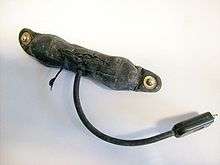Throat microphone



A throat microphone, also laryngophone, is a type of contact microphone that absorbs vibrations directly from the wearer's throat by way of single or dual sensors worn against the neck. The sensors, called transducers, can pick up speech even in extremely noisy or windy environments such as on a motorcycle, or in a nightclub. Other types of microphones do not function well under these conditions because of high levels of background noise. Advanced laryngophones are able to pick up whispers, and therefore perform well in environments where communicating with others at a distance in silence is required, such as during covert military operations. Throat microphones are also very useful when helmets or respiratory protection is required. Many full-face SCBA, CABA, SAR respirator, PAPR or re-breather masks do not have a provision for a microphone inside the mask. The throat microphone can be used safely, as it is positioned outside the mask's face seal and as such does not compromise the respiratory protection provided by the mask, nor does it violate mask approvals and certification.
History
In 1934, aviator Wiley Post incorporated earphones and a throat mic into the design of the world’s first pressure suit to explore the limits of high-altitude, long-distance flight. During World War II German Luftwaffe pilots[1]:176 and panzer crews used the first throat microphones. Soon after, they were adopted by the Allied air forces — USAAF with the T-20 and T-30 and the RAF with the Mark II. Later, Soviet pilots relied on LA-3 and LA-5 models.[2]
Starting in the 1970s, researchers explored the use of throat microphones in speech therapy,[3] especially to relieve stuttering.[4]
Of course, throat microphones have still maintained their presence in the military, SWAT, law enforcement, and emergency services. Newer single-transducer designs are available that make the throat microphone much more comfortable to wear than earlier units and also better balance transmission quality. Additionally, this next generation of throat microphones provides varying outputs and frequency responses to accommodate a wide variety of professional communication devices such as digital and analog portable radios and Terrestrial Trunked Radio (TETRA) and P25 systems.
Several throat microphones now exist for mobile devices.
See also
Notes
- ↑ Reitsch, H., 1955, The Sky My Kingdom, London: Biddles Limited, Guildford and King's Lynn, ISBN 1853672629
- ↑ "Throat Microphone Accessories". Vocomotion.
- ↑ Dewar, Dewar, and Barnes (1976). "Automatic triggering of auditory feedback masking in stammering and cluttering". The British Journal of Disorders of Communication. 11 (1): 19–26. PMID 938616.
- ↑ "Accessories". Casa Futura Technologies. Retrieved 7 July 2011.